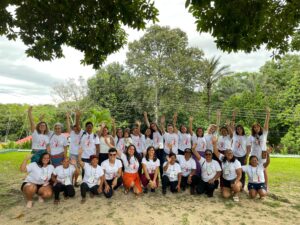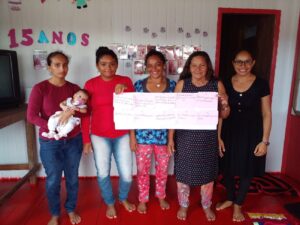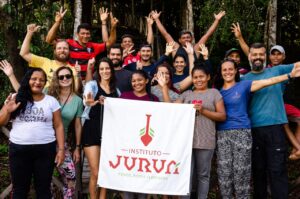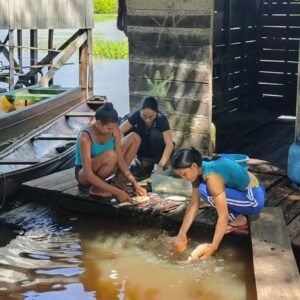Climate change affects biodiverse areas across the planet, and scientists predict a drastic reduction in populations of native species crucial to the agroextractive economy. In the Amazon, the vulnerability of ecosystems to climate change extends to rural communities, which depend economically on the management of natural resources. We invited Dr. André Junqueira to talk about his research which used interviews and monitoring of fisheries, turtle nesting beaches and water levels to assess the current and future impacts of climate change on biodiversity, and on the traditional way of life in the Mid-Juruá. André Junqueira is a biologist, with a PhD in Ecology from Wageningen University, in the Netherlands. André is currently a postdoctoral researcher at the Institut de Ciència i Tecnologia Ambientals (ICTA) of the Universitat Autònoma de Barcelona (UAB), working on the project “Local Indicators of Climate Change Impacts”.
Listen the interview here, only in portuguese.
INSTITUTO JURUÁ. How does climate change affect the Amazon and its biodiversity? What are the main concerns regarding the future of the region in this context?
ANDRÉ JUNQUEIRA. Climate change is a phenomenon that occurs throughout the world, although some places are more affected than others. These changes also influence the Amazon. Some of the most important changes that have been registered in the last decades are the increase of temperature, by almost one degree, in the last 40 years, and changes in precipitation regimes, which leads to changes in the seasonal dynamics of the rivers, such as the flood and dry seasons. River dynamics are strongly connected with the rainfall dynamics, so it is also being affected. These changes do not affect the Amazon in a homogeneous way; some regions are more or less affected than others. For the rains, we even have inverse patterns depending on the location of the basin, so the most eastern and southeastern region of the Amazon already in transition to other biomes tends to get drier, while to the west of the Amazon, in the area closest to the Andes, are areas that are getting rainier. A series of changes in the Amazonian climate and hydrological system have consequences for biological and human systems. Some regions have become increasingly dry, and therefore more susceptible to fire, in some places, according to predictions based on models, the species will change their area of natural occurrence a lot in the face of changes in the climate. Extreme events, such as major floods and major droughts, are naturally occurring events in the Amazon, and are linked to natural climatic cycles such as El Niño and La Niña, but these events have become more and more frequent. All these effects on rains, rivers and species, have several consequences for local communities that depend on and interact directly with the environment and therefore with these changes, which have already been detected in recent decades, but are expected to intensify in the future.
INSTITUTO JURUÁ. The work you have done with other researchers in the Middle Juruá shows the impacts that are already directly affecting the way of life in communities because of climate change, especially global warming. Could you tell us about the interviews, the main impacts reported by the communities and what most caught your attention in these reports?
ANDRÉ JUNQUEIRA. This was a work we conducted in 2020, although it has deeper roots, and Instituto Juruá has been aware of these issues for some time. But we delved more deeply into how the residents of the Middle Juruá are perceiving these changes and what consequences these changes are generating in their way of life. Scientific knowledge about climate change was supported by our survey of local knowledge. Almost everyone talked about the warmer climate, physical discomfort, and it is associated with the higher occurrence of some types of diseases. It is practically unanimous, among the people we interviewed, the idea that no one can stand the work in the fields much longer because it is very hot. In addition, there is the perception that the rain regime is more unpredictable, and the perception that, in general, it has been raining more. This has implications for various activities, for example in agriculture. The idea that river cycles are changing is also very common, that is, that extreme droughts and floods are more frequent and more intense. We know that collecting seeds, such as andiroba, murumuru and ucuuba, is a very important economic activity for several communities on the Juruá River. These species occur in the floodplain areas, which are periodically flooded, and there is a perception that large floods cause greater mortality of these species and hinder the collection activity. It is interesting that there is an idea that these large floods can also have positive effects, for example that in the year following those large floods, fishing is favored. In fact, most of the effects of climate change are negative, but when we look at the refined perceptions of people, we see that there is a complexity of consequences, which we can only observe because we are hearing this from the riverside people. In general, it was an incredible field campaign, as we were always very well received by the communities – they opened the doors of the houses and shared with us a little of their stories and their knowledge about climate change. And it is a work that is just beginning, because we had to postpone some things due to the pandemic, but that will certainly have other consequences.
INSTITUTO JURUÁ. Reading your work, a very interesting issue is the sensitivity of the residents of the Middle Juruá in relation to the perception of the environment, such as the idea that “when a certain plant blooms, we know that the flood will be great” or “the water climbs up to the height where the aruá (Megalobulimus sp.) lays its eggs ”. It is a sensitivity that still escapes science, isn’t it?
ANDRÉ JUNQUEIRA. No doubt! In addition to perceiving changes in the environment in great detail, people also have their strategies for predicting the future. These indicators are observed in plants, in the behavior of animals… However, there is also the idea that, with climate changes, these indicators are becoming less reliable. So, it is an ancestral knowledge, super detailed, developed from a very close relationship with the environment, but which is also being challenged by the new changes that are happening recently.
INSTITUTO JURUÁ. The Middle Juruá is today facing a major flood, which forced many families to leave their homes in the midst of the pandemic, flooded swiddens and caused immense damage to rural communities. Do we need to prepare for the most frequent occurrence of these events? Should we take strategic mitigation or emergency measures for these events?
ANDRÉ JUNQUEIRA. Scientific and traditional knowledge converge, pointing to a future where these situations will be more frequent. So, strategies for dealing with these changes and preparing for them, what we call ‘adaptive strategies’, are very important. Local people have already done this. These changes have not started happening today or yesterday – they have been dealing with them for a while – so they also change their ways of doing and understanding things, based on what is happening. For example, there is the idea that houses should be built taller or the architecture itself should be taller and more airy due to the temperature. They have also changed the time to work in the fields, to avoid the hottest hours of the day. There is a set of reactions to climate change that are already being implemented, and our idea is to identify, with the riverside dwellers, the ideas with the greatest potential to be replicated and those that have already been tested and did not work, so that this knowledge can be shared between communities. It is a huge collection of knowledge, practices and information that they have, and what we are doing in this work is just giving a voice and systematizing that knowledge, but the riverside residents are the great connoisseurs and experts in identifying and developing these strategies to deal with these effects.
INSTITUTO JURUÁ. A study published by Evangelista-Vale and collaborators in Biological Conservation, indicates that some species important for agroextractivism may have their populations significantly reduced in the next 30 years, and Conservation Units may lose the sustainability of their extractive activities. Given that we are still in the process of building the value chains of Amazonian biodiversity, how do you assess the future of agroextractivism in the face of a threat like this?
ANDRÉ JUNQUEIRA. In fact, it is a very big threat. This work showed how several species that are very important, economically and culturally, for different riverside, indigenous, and quilombola communities will tend to become reduced in the future, or at least restricted to smaller areas. This is an effect of climate change, and means that people living today in where these species are expected to disappear in the future, will have their agroextractive activities threatened. And several of these species are fundamental for subsistence, for income… so, thinking about future climatic conditions is something that should be part of the future planning of these production chains. Another important thing to do in this sense is the diversification of productive activities, so if you depend on a species that in the future will be much rarer in your area of occurrence, you are much more at risk than if you depend on several species. So, a more diverse base of activities, as is generally the case in the Middle Juruá, is a strategy more resilient to these climate changes. These models predict that the natural occurrence of these species is expected to decrease, but we know that production systems currently developed by riverside communities and other communities in the Amazon, which involve, for example, shading, agroforestry systems and intensive management, create very specific conditions, and very favorable conditions for the development of some plants. So, it is possible that andiroba (Carapa guianensis) will find its natural occurrence in the forest becoming increasingly rare, but that management systems will favor the maintenance of the species there. The fact that these models indicate a reduction in their occurrence in the future does not necessarily mean that they will disappear completely. But still, it is a very worrying situation, because many of these species in agroforestry systems are extracted from natural ecosystems, for example, Açaí (Euterpe spp.). Although we have cultivated açaí, much of it is extracted from the middle of the forest, in the case of Juruá. So, if this becomes an endangered species in the future, it will really have a very important impact.
INSTITUTO JURUÁ. Do you think that the loss of sustainability in Conservation Units can generate a greater dispute over these territories, which would be conceded by the Union?
ANDRÉ JUNQUEIRA. I think that not only this issue of the reduction in the distribution of some species, but several other threats that surround it, and that are already within the Amazon, tend to exacerbate some of these conflicts. Deforestation itself, the savanization of the Amazon, the reduction of areas susceptible to the occurrence of some important species, and several changes related to land use are already bringing several challenges, and when overlapped with climate change, they make these challenges even greater. If it were just climate change, it would be a huge challenge, if it were just deforestation or land use change, too. But what we have now is the overlap of these things. In addition, there is a cause and consequence effect, as there is evidence to show that, on a regional scale, deforestation influences hydrological dynamics, so it is not only climate change at the global level that affects the Amazon, but changes at the regional level as well. We are in a scenario in which the Amazon is already, and will continue to be, in the face of multiple threats. That is why it is important to identify successful examples of strategies that increase the resilience of communities to climate change, that increase the resilience of productive systems in climate change, and consequently, also increase the resilience of these systems to other changes, to other pressures, which are expected to intensify in the coming decades.
INSTITUTO JURUÁ. How can agroextractive communities and the Amazonian traditional way of life collaborate with science and decision makers in tackling climate change?
ANDRÉ JUNQUEIRA. There is a certain paradox in traditional populations, because while they are very vulnerable to climate change, they also have enormous potential, for similar reasons. Traditional populations, in the world as a whole, share a historical connection with the environment, a very large dependence and a close relationship, which extends even to metaphysical ideas, in addition to the utilitarian relationship. This relationship, and this very direct dependence on the environment, is what puts these populations in a position of vulnerability in relation to climate change, because if these changes affect the environment, on which these people depend so much, their lives will be directly affected. At the same time, precisely because of this historical and close relationship, they have developed a very rich knowledge about the environment. So, this traditional, ancestral and historical knowledge, is the instrument by which these populations are able to identify changes, sometimes very subtle, that are often unknown to science. This is one of the reasons why there has been an increasing global interest in looking at traditional knowledge about climate change, precisely because of this level of detail that exists in this observation of local populations. We see this in the academic sphere, but also in decision-making institutions and political instruments, such as the Intergovernmental Panel on Climate Change (IPCC) and the United Nations (UN). The latest reports from these organizations recognize the importance of incorporating the ways in which local communities understand the world within our global understanding of climate change. And the idea is to look at these different knowledge systems without value judgment, without trying to validate one based on the other, but to think of them as equally valid knowledge systems. Each has its limitations and also its strengths for us to understand this complex phenomenon of climatic changes. The idea of looking at local knowledge is, first, to compile this set of super rich information about these changes. In addition, we do not have very good weather data for various places in the world, but we have people living in these places, and local knowledge can also fill large gaps in information. And there is also an ethical issue in all of this, in which these populations, which are being directly affected by climate change, must be part of the construction of this knowledge and the decision-making process. The IPCC or the UN cannot decide what the strategies for climate change will be without listening to the populations that are, precisely, those most affected by them. That is why traditional knowledge is increasingly given importance to understand climate change and to develop strategies to mitigate its effects. This is our motivation to work in the Juruá – to give voice to these populations, and in some way, to bring to light this knowledge about the changes that are happening in the region.





